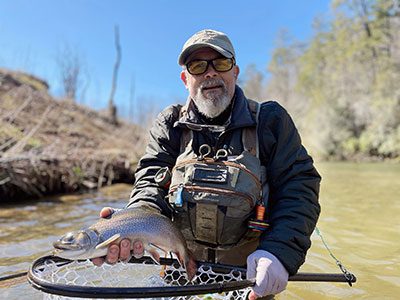Whether enjoying sunny and seventy plus degrees, or a little snow with temperatures in the middle thirties or lower, old Mother Nature sure threw us a few curve balls for March. Moving past the winter blues, and on to the pleasantry of singing birds, blooming forest shrubs, and mayflies and caddis hatches galore, as April comes in, the month truly brings one of the better months of the entire year for dry fly fishing. As the spring weather warms, and thunderstorms arrive to refresh the water system, the rivers streams, and mountain creeks seem to evolve into an abundance of bug life.
Happiness seems to fill those who are familiar with the emergence of all the bug life on the water and frustrate those who are not so intertwined with each and every bug that hatches on the water systems. Luckily, we break that information down for anglers here at the shop, always having a hot list since we are out on the waters to know when things are changing to in order to keep everyone informed. Some of the hatching bugs do not last long while others may last for a few weeks. Understanding the color and size of the mayflies and caddis are important for successful days. Fishing a size ten Stimulator, while being easy on the eyes to pick up after casting into the moving water, may not be the correct fly of choice while a Hendrickson hatch (closer to a size fourteen) is in full swing. If we need to understand one thing throughout all the hatches, it’s that size matters. Some will argue that color is of the utmost importance, and yes, color does matter, but if the bug that is being cast towards rising fish is the wrong size, refusals will happen.
The excitement of seeing rising fish, at times, can bring over-anxious casts, therefore putting the trout back to the bottom of the river bed, not to be seen again for the rest of the day. A stealthy approach, both in choosing outerwear and understanding shadows cast from our appearance on the waterways, casting a good quality floating line along with a longer leader, and great dead drifts of dry flies towards rising fish, will help with a great day on the water. Cautious approaches towards the water, watching the feeding fish, and then a delicate cast upstream, and subtle mends to the fly line, will add great benefits to a successful fishing venture as well.
Striving towards cleaner waterways requires that everyone remember to “Leave No Trace”. This should be the mission we all undertake while enjoying a short stress reliever from work or a vacation in the forest. We hope to see everyone out on the water or during a friendly visit by our full-service shop.
Karl and Karen Ekberg are co-owners of Chattooga River Fly Shop, located at 6832-A Highlands Hwy, Mountain Rest, SC 29664. Give them a call at (864) 638-2806 and visit their website at www.chattoogariverflyshop.com.
